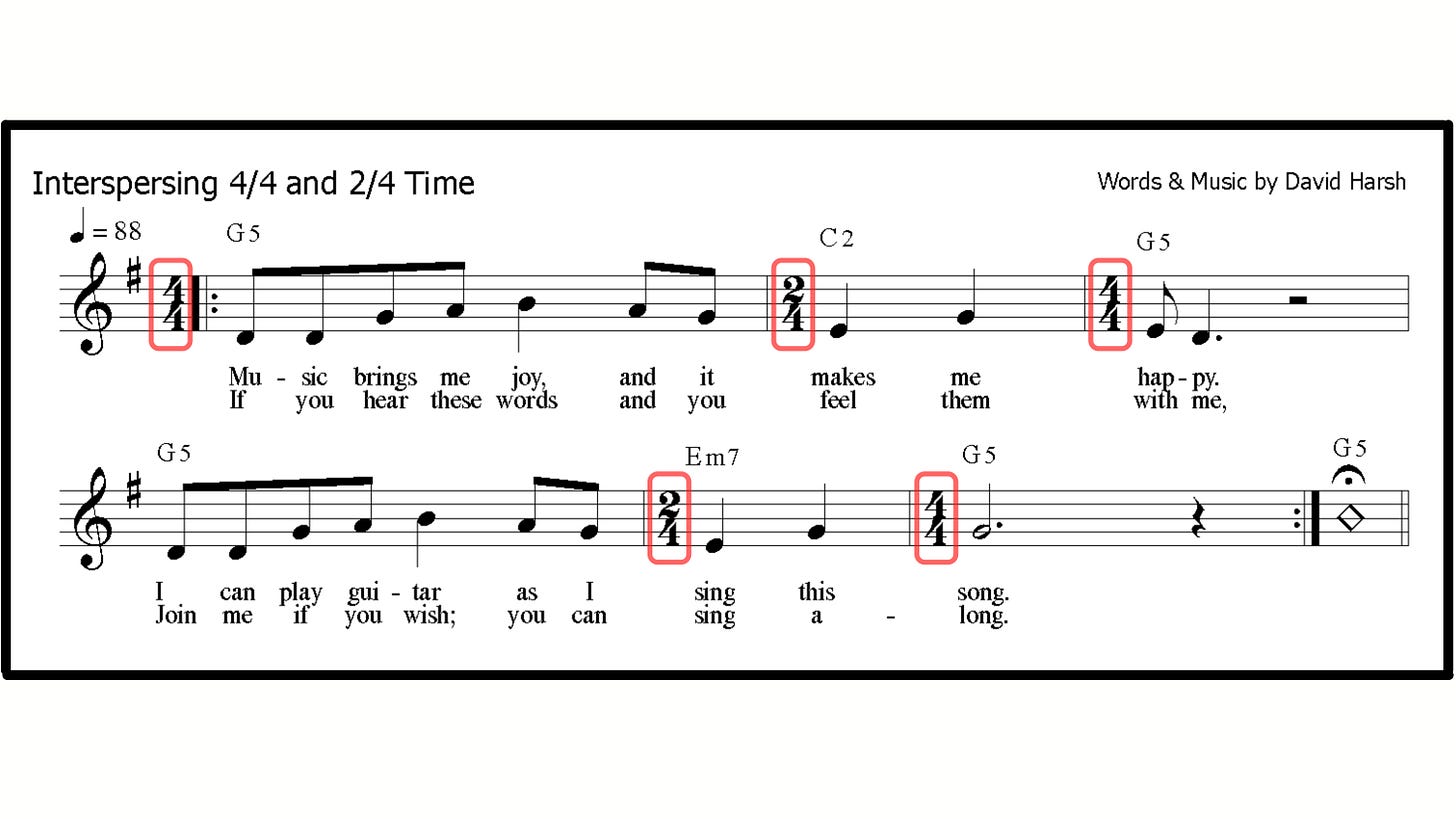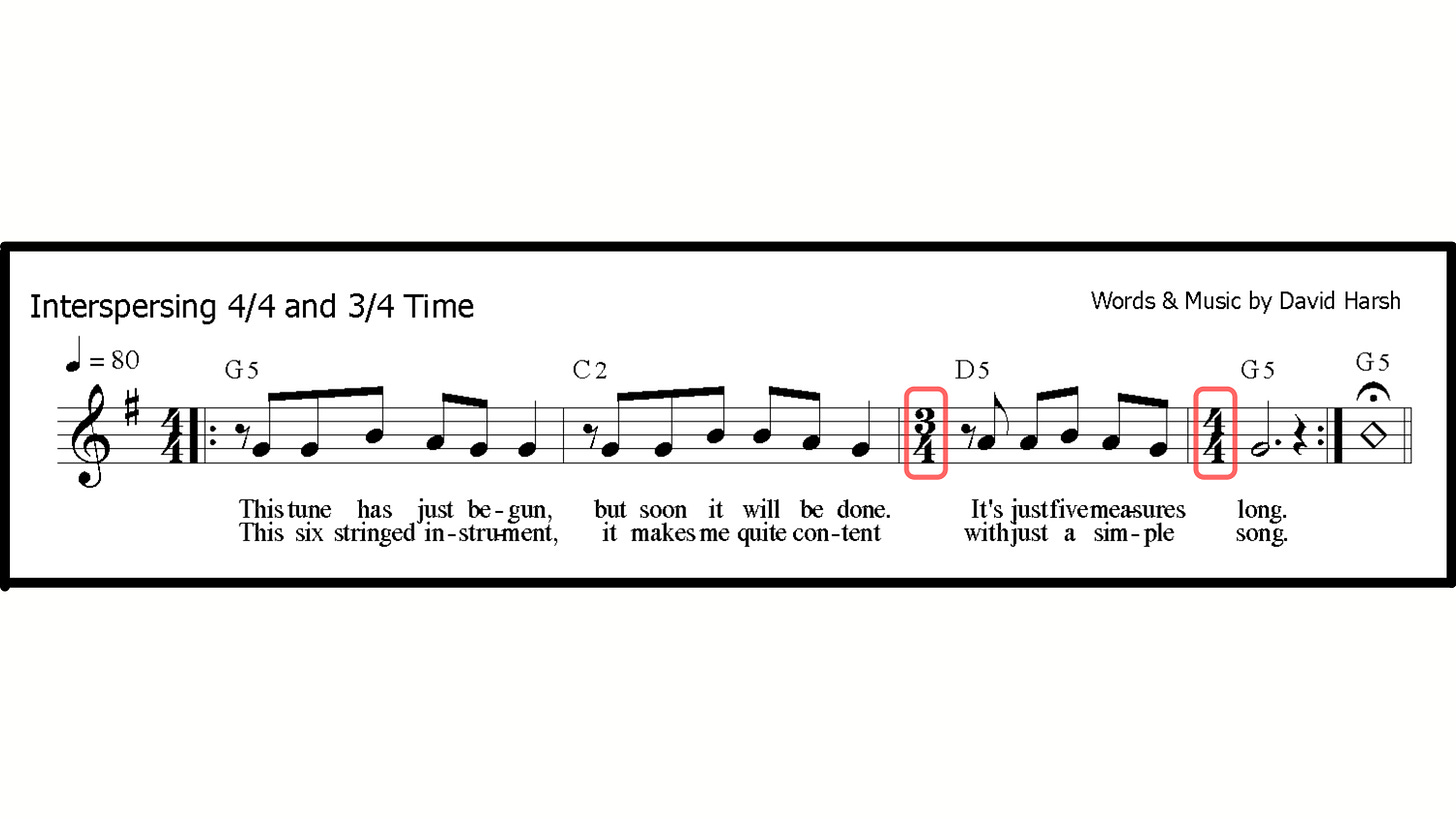Transcript included below…
Pro tip: please watch the short video version of this post that I link to here: https://www.guitarsuccess4u.com/timesigs. It will give you a much clearer grasp of what I’m sharing here.
Are you the kind of guitar player who can sense when the time signature changes in a song? Do you know specifically what’s happening in that moment? If you’re not sure, grab a few minutes with me to widen your gaze a bit.
It’s happened to a lot of us. We’re getting to know a song, and partway through, our ears perk up as we hear the time signature change. What, specifically is going on?
I’d like to suggest a strategy for figuring this out. And it involves raising our game with musical literacy.
As you may know, the time signature for a piece of music consists of two numbers which, for teaching purposes I’ll call the numerator and the denominator. The numerator indicates the number of beats. The denominator provides a clue as to what the signature note value is that gets a beat.
Let’s apply this to the common time signature of 4/4.
The numerator indicates that there are 4 beats in a measure. Here’s what I do to find the signature note value. I take the denominator and place a “1” over it. So, if I put 1 over 4, I have 1/4, or “one quarter,” which gives me the note value that gets the signature beat – a quarter note. So…in 4/4 time, there are 4 beats in a measure, with a quarter note getting a beat.
It follows then that in 2/4 time, there would be 2 beats in a measure, still with a quarter note getting a beat. And even in 3/4 time, we’ll have 3 beats in a measure, but the quarter note will still provide the signature beat.
With this cursory discussion of these time signatures firmly in our grasp, let’s press on to see how they can alternate.
To honor the copyrights of my fellow songwriters, I’ve created two fun musical examples of my own that will illustrate what happens when the time signature momentarily changes.
These examples have vocal melodies (which will make this process even clearer), they’re in G Major (arguably the friendliest key for guitar), and they each start in 4/4 Time.
My first example intersperses 4/4 and 2/4 time. For the 2/4 bar, I just strum down twice, once on each beat (feel free to play along with the video.)
Notice that we are moving from 4/4 to 2/4 time – and back – a total of four times, if we observe the repeat.
It’s clear that the time signature changes work in this example, because the vocal melody feels natural over them. Each phrase has some time to “breathe” when we come back to 4/4 time.
If we just had 4/4 time for every measure, we’d have to quickly regroup after each phrase with very little time to breathe, and I’d argue that it wouldn’t sound as musical.
I’m going to provide an example of what these words and chords might look like if they were found on a chord chart, as opposed to a lead sheet.
What do you notice? The time signature changes are still there, but they’re invisible.
Some chord charts I’ve created may include slashes to show extra beats at the end of each phrase, but in my experience, most chord charts don’t include this extra bit of treatment.
That’s why a lead sheet can be more advantageous than a chord chart, and of course, a recording helps a lot. But a lead sheet also promotes more musical literacy, right?
Let’s look at my second example, where we have a brief departure to (and from) 3/4 time (feel free to play along with the video.)
Again, I’ll provide a chord chart to show you that it can be captured this way, but also to illustrate the fact that the time signature change is once again invisible.
So how do we detect time signature changes mid-song? I’m glad you asked. These are my suggestions.
To get better at detecting time signatures mid-song, I encourage you to:
· Observe the vocal melody (sing it if you can)
· Identify the strumming pattern (or create one)
· Watch for when chord changes happen (they can indicate downbeats)
· Listen to the audio recording, especially the drummer
· Tap your foot and count the beats in each measure as you listen
· Reference a lead sheet (instead of a chord chart), and
· Follow your intuition
A word of wisdom here: let your melody guide you. Sometimes, the melody takes on a bit of a life of its own, and this may necessitate a time signature change. And there are all kinds of possibilities beyond the three time signatures we’ve worked with here.
As you can imagine, This same process applies to writing your own music. If you want to create time signature changes mid-song, you totally can. And there are all kinds of possibilities beyond the three time signatures we’ve worked with here.
We go much deeper on this subject inside the Literacy Stage of my online monthly membership called GuitarSuccess4U. In this stage of our Success Path, we take three solid months to get into intervals, scales, inversions, suspensions, lead sheets, music symbols, and of course, time signatures with many different combinations.
I also have a guest expert interview with a phenomenal drummer who responds to a couple dozen musical examples of varying time signatures, and we make a lot of music and have a whole lot of fun applying what I teach in the membership.
If you’re curious about my approach to digging deep into the guitar, check out GuitarSuccess4U.com so you can learn more about this new approach to unlocking this amazing instrument.
There are so many more tools and techniques waiting for you, along with a community of like-minded guitarists. This could be the opportunity you’ve been waiting for, and I encourage you not to wait.
So, as we wrap up, it’s important to recognize the fact that mid-song time signature changes are quite common. Will we recognize them? Will we take them on with grace, style, and precision? Will we equip our collaborators to do the same?
I’m hoping at this point that you can see the relevance for becoming more aware of this important aspect of the songs we play.
Knowledge is power, but knowledge alone is not enough…we have to do something with it.
So please, go do something with this knowledge you’ve acquired today! And please stay in touch!
















